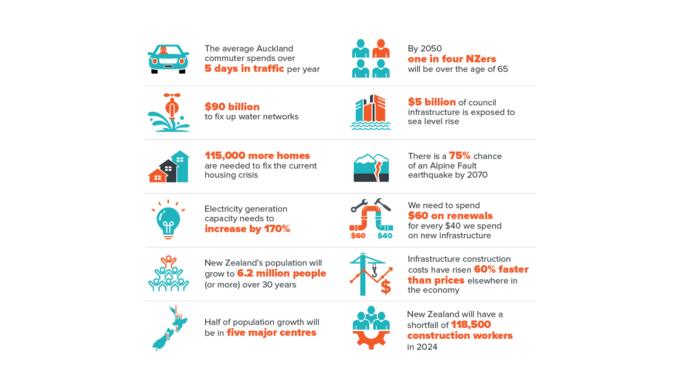The New Zealand Infrastructure Commission, Te Waihanga says New Zealand’s first long-term Infrastructure Strategy sets a vision for how New Zealand’s infrastructure can lay a foundation for the people, places and businesses of the country to thrive for generations.
Tabled by Minister for Infrastructure Grant Robertson, Rautaki Hanganga o Aotearoa – New Zealand Infrastructure Strategy 2022-2052 is the culmination of two years’ independent investigation.
It incorporates feedback from more than 20,000 New Zealanders, more than 700 consultation submissions, and meetings and workshops with stakeholders from all over New Zealand.
Te Waihanga chief executive Ross Copland says it identifies some of the most pressing issues New Zealand is facing, and the changes needed to overcome them.
“Infrastructure is critical to our national objectives and well-being, whether that be the sustained effort needed to meet net zero carbon commitments, ramping up housing supply, easing congestion in our cities, or meeting the expectations for drinking water that is fresh and clean,” Copland says.
“But to meet these ambitions, there are some big decisions and trade-offs that need to be made. Electricity generation capacity needs to increase by some 170% to meet our net zero carbon goals; while it will cost about $90 billion to fix New Zealand’s water networks.
“Some $5 billion of local government infrastructure is vulnerable to sea level rise. These challenges come at a time when construction costs are rising 60% faster than prices elsewhere in the economy, and we expect a shortfall of 118,500 construction workers in 2024,” Copland says.
“More of the same simply won’t cut it. The strategy shows we will have to be smarter about how we plan, deliver and pay for our infrastructure.
“This includes changing the way we pay so we can better manage demand and use of networks.
“We also need a consenting system that actively prioritises meeting our net-zero carbon goals and housing New Zealanders.
“Much of our existing resource management system is not enabling of our national objectives.
“There is a lot of change going on already, and there’s more to be done. We need to make sure all this work delivers what we need, in the best and most efficient way possible,” Copland says.
“In a rapidly changing world, we need to be flexible and adaptable to change, so we will revise this at least every five years. This is the beginning of a much longer-term ongoing conversation with all New Zealanders.”
The Government will prepare its response, which will be shared in September 2022.
Rautaki Hanganga o Aotearoa – New Zealand Infrastructure Strategy 2022-2052 is available at www.strategy.tewaihanga.govt.nz.
Infrastructure Strategy recommendations include:
• Achieving net-zero carbon emissions at minimum cost, and making it easier to leverage our abundant renewable energy resources.
• Making use of tools such as congestion charging on busy roads to make better use of our transport connections.
• Increasing housing opportunities in areas with good access to infrastructure access, and enabling greater and easier urban development through minimum levels of upzoning and mixed use zoning.
• Allowing for water meters to manage demand and encourage water conservation.
• Preparing infrastructure for the impacts of climate change.
• Reducing the amount of waste we create, particularly for products that can’t be recycled.
• Increasing technology use, including greater uptake of real-time data about infrastructure that can help with planning and maintenance — for instance, through digital twins.
• Standardising planning policy across New Zealand and ensuring New Zealand cities plan for significantly more growth.
• Streamlining consenting processes, particularly for infrastructure that helps meet national objectives, such as a zero-carbon economy, and reducing the regulatory burden on construction materials.
• Providing greater certainty for businesses in infrastructure industries to invest in skills and training development, and developing the talent required to deliver New Zealand’s future infrastructure.




